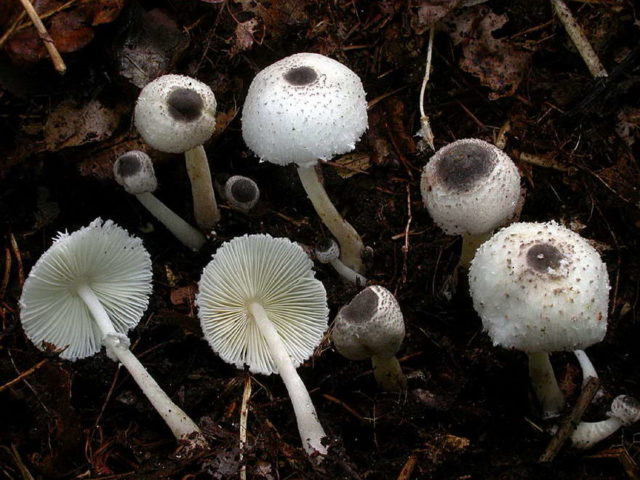Content
Poisonous lepiota is a mushroom from the Champignon family, belonging to the order Lamellar. There is also another name - brick-red lepiota, the Latin name is Lepiota helveola.
What do poisonous lepiots look like?
The hat is round in shape. Its diameter ranges from 2 to 7 cm. Upon careful examination of the poisonous lepiota (pictured), in the center you can see an inconspicuous tubercle and thin radial grooves. The color of the cap is grayish-red, the surface is silky, matte. Numerous scales resembling felt spots form on the cap. Under the cap there are often plates of a pale beige hue. The spores are white, and the spore powder is also white.
The leg is cylindrical, low (from 2 to 4 cm), pink in color. There is no thickening. When cut, it can be revealed that the leg is hollow and fibrous.
The pulp of the mushroom has a sweetish aroma; there is no mushroom taste.
Where do poisonous lepiots grow?
Poisonous lepiots are found in Western Europe, as well as in Ukraine. The main habitat of mushrooms is park areas, meadows, and grassy areas.
Poisonous lepiots are considered rare mushrooms; they appear in the autumn.
Is it possible to eat poisonous lepiots?
These mushrooms are classified as poisonous. Their consumption is prohibited.
Symptoms of poisoning
Lepiota poisoning is life-threatening. It contains cyanides and nitriles, for which there is no antidote.
The first symptoms of poisoning appear a quarter of an hour after the mushrooms enter the body. The victim exudes white foam from the mouth, resulting from multiple ruptures of the alveoli in the lungs. Cardiac arrest can occur within 30 minutes. These two factors lead to death.
The victim's body temperature may increase. Continuous vomiting, shortness of breath, foamy discharge from the mouth, blue discoloration of the body or the appearance of cyanotic spots indicate poisoning with poisonous lepiota.
First aid for poisoning
The faster first aid is provided for mushroom poisoning, the greater the person’s chances of survival. Algorithm of action for mushroom poisoning:
- call a medical team or take the victim to the hospital;
- perform gastric lavage;
- give the victim a laxative;
- to avoid dehydration, the patient is given plenty of fluids;
- Remains of food that caused poisoning should be preserved. This will allow you to clarify the type of poison.
Prevention recommendations
To avoid poisoning, you need to collect mushrooms correctly:
- unknown or questionable specimens do not need to be picked;
- mushrooms grown in garbage bins, city landfills, along highways and near chemical plants cannot be collected or processed. Fruiting bodies quickly absorb toxic substances and can therefore cause poisoning;
- overgrown or damaged ones are also better left in the forest. Poisoning often occurs when consuming old edible mushrooms;
- Small children should not be taken to mushroom picking. They often pull into their mouths whatever they like, for example, a red fly agaric cap;
- You cannot purchase mushrooms from people selling in spontaneous markets along highways;
- processing technology must be strictly followed. Conditionally edible specimens are boiled twice, for at least 20 minutes each time, the water is not reused.
Doubles and their differences
Poisonous lepiota can be confused with small specimens of the same family. For example, the parasol is a poisonous representative of the fungal kingdom, externally resembling poisonous lepiota. The umbrella's cap is beige or reddish in color, and its surface is covered with small scales. The pulp is yellow, with a pleasant smell.
Fruits from August to September and is found in small groups.
Lepiota Brebisson has a conical cap with a diameter of 2 to 4 cm. In adult specimens it opens. A reddish-brown tubercle is clearly visible on the cap.The scales on the surface are sparse and brown in color. The shape of the leg is cylindrical, the color is fawn, purple-violet at the base. A fragile ring forms on the stem. The season for the appearance of these specimens is autumn.
Conclusion
Lepiota poisonous is dangerous to human health. Eating them can lead to paralysis of the lungs and death, so when hunting quietly you should be extremely careful not to collect poisonous specimens in the basket.











